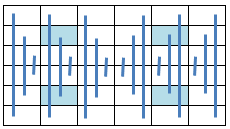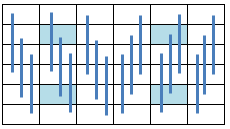Office Applications and Entertainment, Magic Squares | ||
|
|
Index | About the Author |
|
6.10 Magic Squares, Rectangular Compact
In Section 2.4 the property ‘Compact’ has been introduced as: Each 2 x 2 Sub Square sums to 4 * s1 / n.
6.10.2 Partly Rectangular Compact
A Magic Square can be referred to as Partly Rectangular Compact,
when only the six non overlapping Sub Rectangles (2 x 3) sum to the Magic Sum:
a( 1) + a( 2) + a( 3) + a( 7) + a( 8) + a( 9) = s1 a( 4) + a( 5) + a( 6) + a(10) + a(11) + a(12) = s1 a(13) + a(14) + a(15) + a(19) + a(20) + a(21) = s1 a(16) + a(17) + a(18) + a(22) + a(23) + a(24) = s1 a(25) + a(26) + a(27) + a(31) + a(32) + a(33) = s1 a(28) + a(29) + a(30) + a(34) + a(35) + a(36) = s1
which can be added to the equations describing a Simple Magic Square of the sixth order (ref. Section 6.2).
a(31) = s1 - a(32) - a(33) - a(34) - a(35) - a(36)
a(28) = s1 - a(29) - a(30) - a(34) - a(35) - a(36)
a(25) = s1 - a(26) - a(27) - a(28) - a(29) - a(30)
a(19) = s1 - a(20) - a(21) - a(22) - a(23) - a(24)
a(16) = s1 - a(17) - a(18) - a(22) - a(23) - a(24)
a(13) = s1 - a(14) - a(15) - a(16) - a(17) - a(18)
a(11) = 4*s1 + a(12) + a(17) + 2*a(18) - 2*a(19) - 2*a(20) - 3*a(21) - a(22) - a(23) - 2*a(25) +
- 3*a(26) - 2*a(27) - a(28) - a(29) - 3*a(31) - 2*a(32) - 2*a(33) - a(34) - a(35)
a( 8) = (- a( 9) - a(10) - 2*a(12) - a(14) - 2*a(15) - a(17) - 2*a(18) + 2*a(19) + a(20) + 2*a(21) +
+ a(23) + 2*a(25) + 2*a(26) + a(27) + a(28) + 2*a(31) - 2*a(36))/2
a( 7) = s1 - a( 8) - a( 9) - a(10) - a(11) - a(12)
a( 6) = s1 - a(12) - a(18) - a(24) - a(30) - a(36)
a( 5) = s1 - a(11) - a(17) - a(23) - a(29) - a(35)
a( 4) = s1 - a(10) - a(16) - a(22) - a(28) - a(34)
a( 3) = s1 - a( 9) - a(15) - a(21) - a(27) - a(33)
a( 2) = s1 - a( 8) - a(14) - a(20) - a(26) - a(32)
a( 1) = s1 - a( 7) - a(13) - a(19) - a(25) - a(31)
The linear equations shown above are ready to be solved, for the magic constant s1 = 111.
A Magic Square is Rectangular Compact when all 2 x 3 Sub Rectangles sum to the Magic Sum, which property is covered by following equations:
Σ a(i + j) = s1 with 1 =< i =< 28 and i ≠ 6 * n and i ≠ (6 * n - 1) for n = 1 ... 5
which can be added to the equations describing a Simple Magic Square of the sixth order (ref. Section 6.2).
a(31) = s1 - a(32) - a(33) - a(34) - a(35) - a(36) a(28) = s1 - a(29) - a(30) - a(34) - a(35) - a(36) a(27) = a(30) - a(33) + a(36) a(26) = a(29) - a(32) + a(35) a(25) = -a(29) - a(30) + a(32) + a(33) + a(34) a(22) = - a(23) - a(24) + a(34) + a(35) + a(36) a(21) = a(24) + a(33) - a(36) a(20) = a(23) + a(32) - a(35) a(19) = s1 - a(23) - a(24) - a(32) - a(33) - a(34) a(16) = s1 - a(17) - a(18) - a(34) - a(35) - a(36) a(15) = a(18) - a(33) + a(36) a(14) = a(17) - a(32) + a(35) a(13) = a(17) - a(18) + a(32) + a(33) + a(34) a(12) = 7*s1/3 - a(17) - 2 * a(18) - a(30) - 2 * a(32) - 2 * a(34) - a(35) - 4 * a(36) a(11) = s1/3 - a(29) a(10) = -8*s1/3 + a(17) + 2 * a(18) + a(29) + a(30) + 2 * a(32) + 3 * a(34) + 2 * a(35) + 5 * a(36) a( 9) = 7*s1/3 - a(17) - 2 * a(18) - a(30) - 2 * a(32) + a(33) - 2 * a(34) - a(35) - 5 * a(36) a( 8) = s1/3 - a(29) + a(32) - a(35) a( 7) = -5*s1/3 + a(17) + 2 * a(18) + a(29) + a(30) + a(32) - a(33) + a(34) + a(35) + 4 * a(36) a( 6) = -4*s1/3 + a(17) + a(18) - a(24) + 2 * a(32) + 2 * a(34) + a(35) + 3 * a(36) a( 5) = 2*s1/3 - a(17) - a(23) - a(35) a( 4) = 5*s1/3 - a(18) + a(23) + a(24) - 2 * a(32) - 3 * a(34) - a(35) - 4 * a(36) a( 3) = -4*s1/3 + a(17) + a(18) - a(24) + 2 * a(32) - a(33) + 2 * a(34) + a(35) + 4 * a(36) a( 2) = 2*s1/3 - a(17) - a(23) - a(32) a( 1) = 2*s1/3 - a(18) + a(23) + a(24) - a(32) + a(33) - a(34) - 3 * a(36)
The solutions can be obtained by guessing:
6.10.4 Rectangular Compact, Axial Symmetric
Although Rectangular Compact Magic Squares can't be Diagonal Symmetric they can be Axial Symmetric.
a(31) = s1 - a(32) - a(33) - a(34) - a(35) - a(36) a(28) = s1 - a(29) - a(30) - a(34) - a(35) - a(36) a(27) = a(30) - a(33) + a(36) a(26) = a(29) - a(32) + a(35) a(25) = - a(29) - a(30) + a(32) + a(33) + a(34) a(23) = - s1 - 2 * a(24) + 2 * a(32) + 2 * a(34) + a(35) + 4 * a(36) a(22) = s1 + a(24) - 2 * a(32) - a(34) - 3 * a(36) a(21) = a(24) + a(33) - a(36) a(20) = - s1 - 2 * a(24) + 3 * a(32) + 2 * a(34) + 4 * a(36) a(19) = 2*s1 + a(24) - 3 * a(32) - a(33) - 3 * a(34) - a(35) - 4 * a(36)
The solutions can be obtained by guessing:
6.10.5 Rectangular Compact, Row Symmetric, Pan Magic
When the equations defining Row Symmetry as illustrated below:
a(32) = s1/2 - a(34) - a(36) a(31) = s1/2 - a(33) - a(35) a(28) = s1 - a(29) - a(30) - a(34) - a(35) - a(36) a(27) = a(30) - a(33) + a(36) a(26) = -s1/2 + a(29) + a(34) + a(35) + a(36) a(25) = s1/2 - a(29) - a(30) + a(33) - a(36) a(22) = - a(23) - a(24) + a(34) + a(35) + a(36) a(21) = a(24) + a(33) - a(36) a(20) = s1/2 + a(23) - a(34) - a(35) - a(36) a(19) = s1/2 - a(23) - a(24) - a(33) + a(36)
and appears to be Pan Magic as well.
The obtained results regarding the miscellaneous types of order 6 Rectangular Compact Magic Squares as deducted and discussed in previous sections are summarized in following table: |
Type
Characteristics
Subroutine
Results
Simple
Non Overlapping Rectangles (2 x 3)
Rect. Compact
General
Axial Symmetric
Row Symmetric, Pan Magic
|
Comparable routines as listed above, can be used to generate alternative types of order 6 Magic Squares,
which will be defined in following sections.
|
|
|
Index | About the Author |

